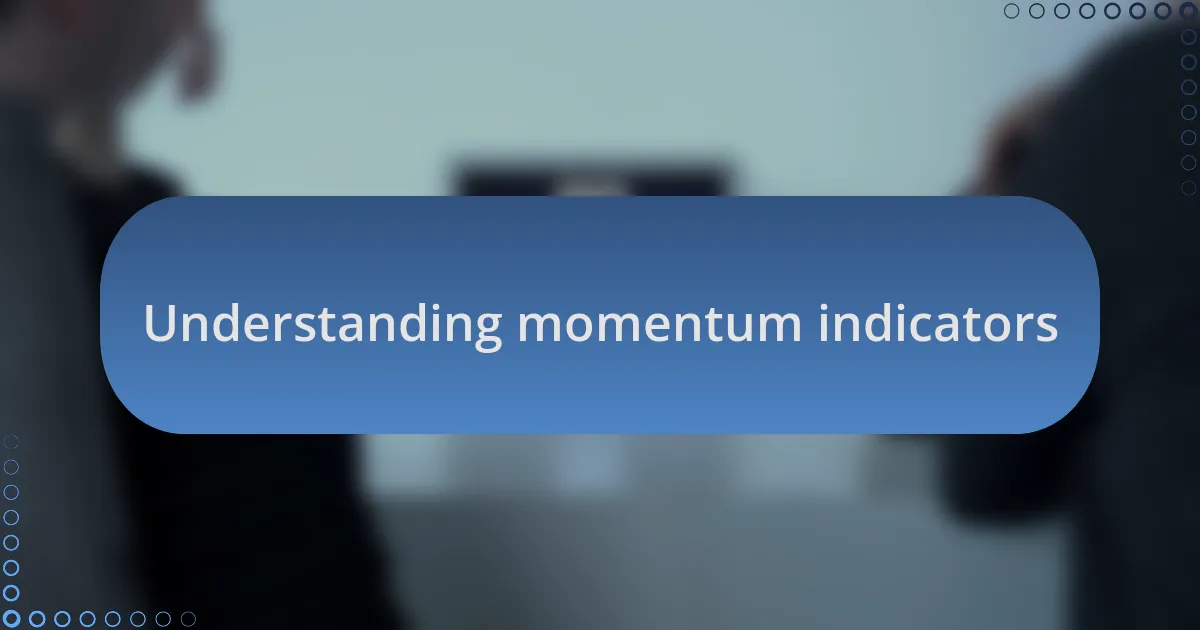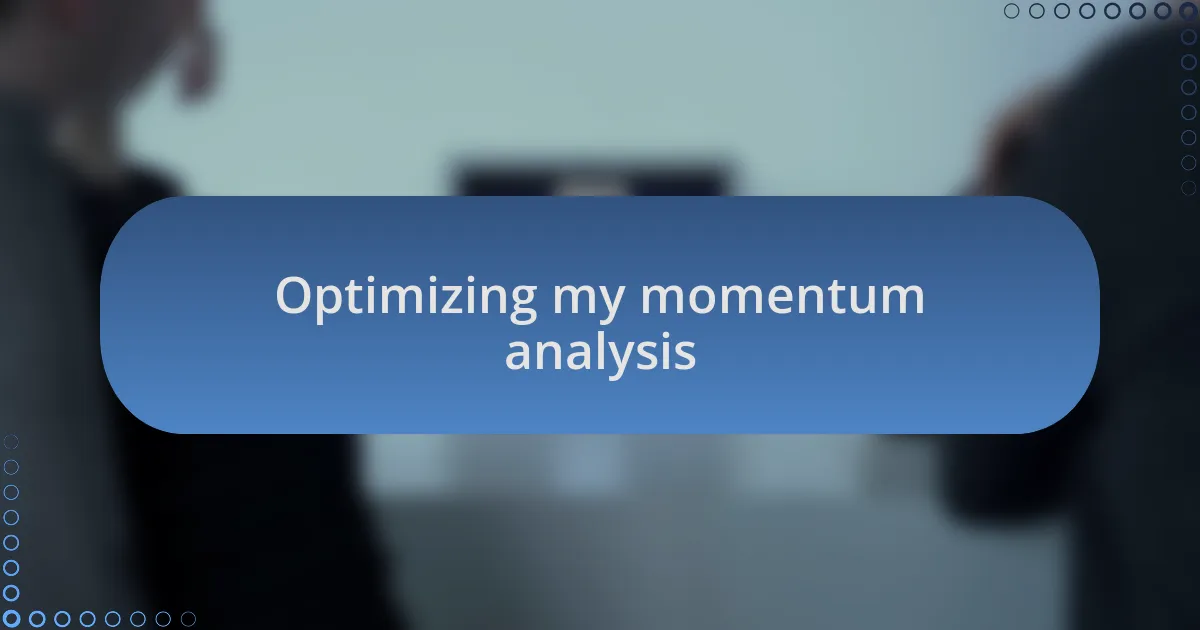Key takeaways:
- Momentum indicators, like RSI and MACD, are crucial for anticipating price shifts and making informed trading decisions in cryptocurrencies.
- Timing is vital in trading; missing the right moment can significantly impact profits or losses.
- Using a combination of indicators and adjusting time frames enhances the effectiveness of momentum analysis and decision-making.
- Avoid relying too heavily on a single metric or getting distracted by short-term fluctuations to maintain a clear perspective on market trends.

Understanding momentum indicators
Momentum indicators are essential tools in the world of trading, particularly when it comes to analyzing cryptocurrencies. I remember the first time I used the Relative Strength Index (RSI), which measures the speed and change of price movements; it really opened my eyes to the potential of spotting overbought or oversold conditions. Have you ever found yourself in a situation where the market suddenly turned, and you wished you had an earlier signal? Understanding these indicators can help you anticipate price shifts before they happen.
These indicators, like the Moving Average Convergence Divergence (MACD), can indicate shifts in momentum that are crucial for making informed trading decisions. I’ve frequently relied on the MACD in my own trading strategies, noticing how it highlights the relationship between two moving averages of a security’s price. It’s fascinating how a slight change in these values can lead to significant insights; have you tried this approach in your own analysis?
In my experience, mastering momentum indicators requires practice and observation. Each trader can interpret them differently based on their style and risk appetite. For instance, one trader might thrive on the excitement of a breakout signaled by momentum, while another may prefer to play it safe and stay grounded in established trends. What’s your approach to interpreting these indicators; do you follow the crowd, or carve out your distinct path?

Importance of momentum in crypto
Momentum plays a vital role in the cryptocurrency market due to its high volatility. I recall one particular trading day when Bitcoin surged dramatically in response to positive news. The momentum was palpable, and it reminded me of how essential it is to harness that energy. Have you ever experienced a sudden rush in the market? Recognizing that momentum can be the key to capitalizing on such moments.
The ability to track momentum indicators, like the Stochastic Oscillator, can provide deep insights into potential price reversals or continuations. I remember looking at a chart where the Stochastic suggested overbought conditions just before a steep correction. It was a wake-up call for me. How often do you check these indicators in your analysis? They can truly serve as a compass, guiding you through the uncertain waters of crypto trading.
If I had to choose one lesson about momentum, it’s the importance of timing. In the fast-paced world of crypto, missing the right moment can mean the difference between profit and loss. One time, I hesitated too long to enter a trade, and the opportunity slipped away, leaving me frustrated. When analyzing momentum, do you feel the thrill of potential gains or the anxiety of missing out? Understanding this aspect can profoundly affect your trading psychology.
![]()
Tools for tracking momentum indicators
When it comes to tracking momentum indicators, the right tools can make a significant difference. I personally enjoy using trading platforms like TradingView, which offers comprehensive charting capabilities and a variety of momentum indicators. Have you ever felt overwhelmed by too many metrics? The user-friendly interface allows me to focus on what truly matters without unnecessary distraction.
Another powerful tool I’ve found is the Relative Strength Index (RSI). It’s a must-have in my analytical arsenal, as it quickly signals overbought or oversold conditions. I vividly remember a time when the RSI flagged a potential drop for Ethereum, which helped me decide to take profits just in time. Do you regularly incorporate the RSI into your strategy, or are there other indicators you prefer?
Additionally, mobile apps like CoinMarketCap provide real-time data and momentum analysis on the go. During a particularly busy trading session, I found myself using the app to check for momentum shifts while I was out and about. Have you ever been in a scenario where your ability to act swiftly was crucial? Having access to such tools can empower you to take advantage of fleeting opportunities in the fast-moving crypto market.

My approach to analyzing trends
Analyzing trends is a deeply personal process for me; I rely heavily on historical data and price patterns to inform my decisions. For instance, I remember watching a Bitcoin rally unfold, where the price consistently bounced off a specific support line. I found a sense of excitement tracking this pattern, reinforcing my belief in the importance of recognizing recurring trends. Have you experienced that thrill when a trend aligns perfectly with your analysis?
When assessing trends, I always pay attention to volume indicators. A notable moment for me was during a sudden spike in trading volume for a lesser-known altcoin. It hinted at growing interest and foreshadowed a significant price movement. I can’t help but wonder, how many traders miss these clues that volume can provide?
I also like to keep an eye on social media sentiment, which often correlates with price movements. A couple of weeks ago, I noticed an unexpected surge in positive sentiment about a specific DeFi project on Twitter. This environment of excitement prompted me to explore the project further, ultimately leading to a rewarding investment. Have you ever found yourself driven by the buzz of social media? It’s fascinating how trends can begin in such seemingly casual spaces.
![]()
Techniques for effective tracking
Tracking momentum indicators effectively requires a combination of tools and intuition. One method I find invaluable is using moving averages to smooth out price data. During a particularly volatile week, I decided to apply both short-term and long-term moving averages. This approach helped me identify not just the immediate price movements but also the overarching trend. Have you ever noticed how a simple line can clarify the chaos in the charts?
Incorporating oscillators, like the Relative Strength Index (RSI), adds another layer of analysis. I recall isolating a few overbought signals on Ethereum during a peak period; it was thrilling to watch how the market corrected shortly after. I wondered, how many traders had the same insights, yet chose to ignore the warnings? Oscillators can provide crucial insights, allowing us to refine our entries and exits.
Another effective technique is setting alerts to stay updated on key levels without constant monitoring. When I first started using price alerts, it felt like having a personal assistant, nudging me precisely when opportunities arose. I still remember waking up to an alert on a significant drop in a coin I tracked closely—it was a wake-up call that led to a timely buy. Have you ever wished for a system that simply taps you on the shoulder when it matters most?
![]()
Common mistakes in tracking
Tracking momentum indicators can be tricky, and one common mistake I often see is relying too heavily on a single metric. I remember a time when I fixated solely on the RSI, convinced it was my golden ticket to predict market moves. Unfortunately, that narrow focus led me to miss critical signals from other indicators, which could have provided a more rounded perspective. Have you ever felt blindsided because you overlooked valuable information?
Another pitfall is getting caught up in the noise of short-term fluctuations. I’ve had days where I reacted impulsively to every little dip or spike, thinking I was being proactive. In reality, this frantic approach only fueled my anxiety and clouded my judgment. It’s essential to step back and view the bigger picture; have you found yourself needing to recalibrate your focus when the market gets too chaotic?
Lastly, failing to adjust strategies as market conditions change is a significant error I’ve made in the past. There were periods when my tracking methods became outdated, but I stubbornly clung to them. Adapting to shifting trends is vital; sometimes, I like to think of it as tuning a musical instrument—if you don’t make adjustments, the harmony is lost. Have you taken the time to reflect on whether your techniques still resonate with the current market environment?

Optimizing my momentum analysis
When optimizing my momentum analysis, I’ve discovered that using a combination of indicators enhances my decision-making. For instance, pairing the Moving Average Convergence Divergence (MACD) with the Stochastic Oscillator has often provided clearer signals than relying on one of them alone. Have you ever experimented with combining different tools to see which offers the best insight for your strategies?
Another way I fine-tune my analysis is by adjusting my time frames. Early in my trading journey, I stuck to daily charts, believing they offered a comprehensive view. However, I’ve learned that sometimes, drilling down to hourly or even minute charts can reveal subtle momentum shifts that go unnoticed at a broader level. Do you think you might benefit from changing your perspective on time frames?
Finally, I find that setting clear entry and exit points based on momentum indicators helps me stay disciplined. Initially, I would react on instinct, which often led to second-guessing my choices. By establishing rules rooted in my analysis, I can approach the market with greater confidence. Isn’t it liberating to have a plan that directs your actions instead of letting emotions dictate your trades?